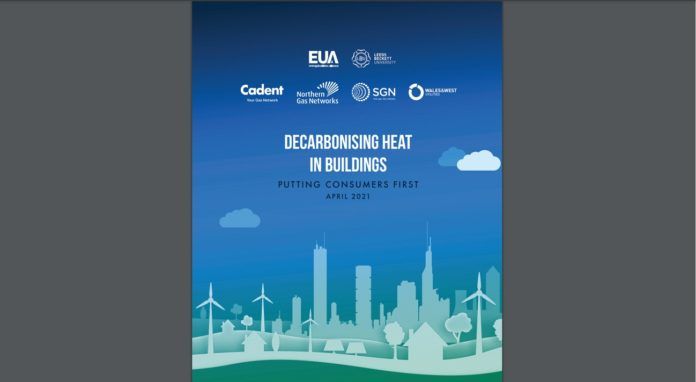
Heat pumps will not achieve UK domestic heat decarbonisation by 2050 if they are not supported by a mosaic of heating solutions, including a hydrogen gas network, a new report reveals.
Published by the Energy and Utilities Alliance (EUA) in partnership with Leeds Beckett University and UK gas distribution networks Cadent, Northern Gas Networks, SGN and Wales & West Utilities, ‘Decarbonising heat in buildings: putting consumers first’ explores the challenges of retro-fitting various low carbon heating technologies into dwellings vastly differing in size, age and construction, as well as customer acceptance of these solutions.
The report also highlights that although energy efficiency will be crucial to net zero targets, some measures supporting heat pump rollout will be intrusive to install, and less acceptable to energy customers.
In addition to examining external building fabric, the report recommended further analysis should be undertaken to consider the internal system changes needed for heat pumps and hydrogen boilers. This included the suitability of radiators for the low carbon transition, and potential changes to hot water cylinders should combi-boilers be replaced with heat pumps.
While heat pumps will play a vital role in the UK’s net zero transition – for between seven and 10 million homes there are no limiting factors to installation – the EUA report findings showed that for existing UK housing stock, levels of disruption and association costs as well as lack of available space means that heat pumps will be an optimal solution for a minority of properties.
What’s more, the independent analysis found that for eight to 13 million homes’ – 37% to 54% of the 22.7 million homes using gas – lack of exterior space and thermal properties of building fabric means a heat pump is not capable of meeting the space requirements of the property, or can only do so through disruptive measures such as solid wall insulation.
The report recommended their use must be supported by a decarbonised gas network carrying a gas such as hydrogen, which is zero carbon at the point of use.
Moreover, up to 4 million homes could be made suitable for heat pump retrofit through energy efficiency measures such as cavity wall insulation, it said.
However, levels of disruption to customers through installation, as well as the cost of significantly upgrading the electricity distribution network to cope with large numbers of heat pumps operating at peak time, meant these properties may be better served through gas-based technology and a decarbonised gas network.
The UK’s gas transportation infrastructure can be converted incrementally from natural gas to hydrogen to support the switchover with limited disruption to customers in their homes.
Several UK demonstrations of hydrogen as technology supporting decarbonisation of heat have already demonstrated the technical and economic feasibility of a conversion.
Mike Foster, chief executive officer of the EUA, said: “Heat pumps will play a key role in the future of heat. However, it’s important to recognise that for them to work effectively as the sole heating source, the building needs to be thermally efficient, and they require internal and external space as well as changes to internal systems such as radiators.
“Levels of disruption to people in their homes and associated costs mean heat pumps will be a solution for a minority of properties only, so hydrogen, biogas and hybrid systems need to play a significant role in the decarbonisation of heat to support our 2050 net zero ambition.
“This analysis shows a house-by-house heating solution is needed, and any thoughts to carve up the UK and force regional solutions upon consumers will be doomed to fail.”
Tim Harwood, H21 programme director at Northern Gas Networks, added: “Switching to low carbon heat is likely in many instances to require changes to appliances within our homes and offices, as well as the building itself. When we take these points into consideration, we need an approach that focuses on investment and people’s experience of heating technologies in equal measure as customers need to be part of this journey.
“Different heating technology solutions are going to be applicable to different property types depending on the age, and profile of the building, and the capacity of energy networks.”
